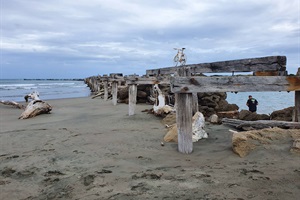Community feedback sought on South Mole works
Published on 01 April 2022

Together with hapū and project partners of Te Pūwaha: Whanganui Port revitalisation project, Horizons Regional Council will be sourcing input from the community on their next stage of repair and reinstatement works – the South Mole.
This is part of the wider Te Pūwaha project to secure the Whanganui Port as a valuable community asset for the next 50 years and beyond. In addition, the repairs to the South Mole, alongside those at the North Mole enable an operational port, as they define the river mouth and ensure a navigable depth is maintained for vessels, while also protecting essential port and city infrastructure from flooding.
As with all aspects of Te Pūwaha, the process for the South Mole is to be open and inclusive, where communities are informed and engaged at every stage. This approach is being undertaken simultaneously with Whanganui District Council who are currently engaging on proposed dredging and the possibility of using the dredged materials to create a new ecological and recreational community area. Together, project leaders have followed a community led approach under Tupua te Kawa which acknowledges the deep connection between the community and the Whanganui River.
Activities under the proposed works include carting and stockpiling rock to the open space in the dunes near the airport and then along the beach to the South Mole, along with strengthening and reinstatement of the Mole using large armour rock, much like that currently being used at the North Mole. The reinstatement of the Tanae Groyne is also included, extending a length of 50 metres into the river from the base of the South Mole.
“We want to build a structure that is fit for purpose, but we deeply care about how we do the work, and consider the engagement at a catchment wide level, says Jon Roygard, Horizons group manager catchment operations.
“The planned works will include rehabilitation of the dune system where we impact on it, and we will continue to work with hapū through Te Mata Pūau, and broader community interests to determine potential future environmental enhancements in this important coastal environment.”
“This project has been done in a way where the community, inclusive of hapū, have placed the wellbeing of the river system at the heart of the project,” says Hayden Turoa, Te Pūwaha project director.
“The planning process adopted by Te Pūwaha recognises the importance of collaboration with the community, with opportunities for all to share their aspirations for abundance outcomes for the area,”
“For example, we are currently investigating how we can improve the way we work together when planning, and how to provide additional habitat for marine life on the coastal and estuarine margins and enhance this special part of our coastline.”
An application for consent for the proposed works will be lodged in May/June this year. Jointly funded by Horizons, Whanganui District Council and Kānoa – Regional Economic Development & Investment Unit, works on the ground are expected to commence during the 2022/23 summer months - when sea conditions are at their most favourable for construction.
Community are invited to find out further information and provide feedback on the proposed works via www.whanganui.govt.nz/port.
Acknowledgements:
Te Pūwaha would like to acknowledge Te Awa Tupua and its communities, who are integral to the port revitalisation project.
The total investment in Te Pūwaha is over $50 million, with the infrastructure works carried out over three tranches or phases. This includes a $26.75 million government investment managed by Kānoa - Regional Economic Development & Investment Unit, with the remaining cost and resources covered by Whanganui District Council, Horizons Regional Council, Q-West Boat Builders, and the Whanganui District Employment Training Trust (Port Employment Precinct).